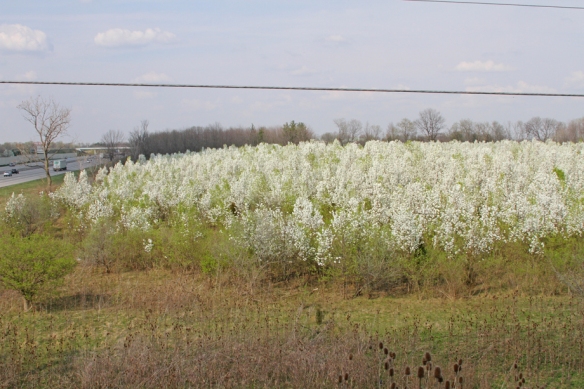When we built our house in 1992, we had a fencerow that separated our backyard from the 5-acre home lot behind us. Nothing unusual grew in the fencerow: thorny wild floribunda roses were plentiful. Somewhere in the last 20 years the roses bushes went the by-and-by and the invasive Amur bush honeysuckle (Lonicera maackii) took its place with a hyperdrive growth habit. Having enough of losing my backyard to these gigantic shade-killing, tree wannabes, I am fighting back with a handsaw, a saws-all and a soon to arrive chainsaw. The largest beast is nearly 5 feet in circumference at the base!
Last year the power line maintenance crew came through and took a scoop out of the middle of the row. That only aggravated the honeysuckle enough to send up gazillions of 4-6′ sprouts in retaliation. I asked the work crew to take it all (por favor) but was turned down. This removal process is turning out to be quite the stress reliever. Nothing like a power tool to bring a smile to one’s face.

A field of Callery Pear trees gone wild around the 25 mile marked on I-75. (Photo by Joe Boggs, Asst. Professor OSU and OSU Extension of Hamilton County, OH)
I should be grateful that my horticultural foe is the Amur honeysuckle and not the Callery pear (Pyrus calleryana). You can’t miss them right now – they are everywhere man did not plant them. You say, “I thought the flowering pear was sterile.” The National Park Service notes, “While some plant genotypes are self-incompatible, meaning they require cross pollination from another genotype in order to set seed, others can pollinate themselves. Different genotypes growing near each other (e.g., within about 300 ft.) can cross-pollinate and produce fruit with viable seed.” Apparently, that’s how we got to where we are.
Once established Callery pear forms dense thickets that push out other plants including native species that can’t tolerate the deep shade or compete with pear for water, soil and space. To make matters worse, they have thorns and even crowd out the Amur honeysuckle!
What to do? First: do NOT plant Callery pear or any Callery pear cultivars including the well known Bradford pear. Second: cut down or pull out any volunteers that sprout on your property. Some alternative trees to consider for landscape use include: common serviceberry (Amelanchier arborea), Allegheny serviceberry (Amelanchier laevis), shadbush or juneberry (Amelanchier arborea, Amelanchier laevis), alternate-leaved dogwood (Cornus alternifolia), blackhaw (Viburnum prunifolium), or cockspur hawthorn (Crataegus crus-galli).
Read more about the Callery pear at this Ohio Division of Natural Resources Division of Forestry’s PDF: Weed of the month on Callery Pear.

I know what you mean about the honeysuckle. Our neighbor owns the woods behind us. He has let the honeysuckle take over a large swath of the border between his property and a line of about 10 properties, including ours. Where there was once a lovely line of wildflowers, redbuds, crabapples, and mulberry trees, there is now a tangle of honeysuckle, wild grape vine, suckering something-or-other, garlic mustard, and poison ivy. Oh, and I almost forgot the nearly-dead trees that have dropped huge limbs. I haven’t seen Callery pear, but it wouldn’t surprise me to see it rising from the jungle. I guess if he doesn’t see his infested mess, he can pretend it doesn’t exist. We can’t.